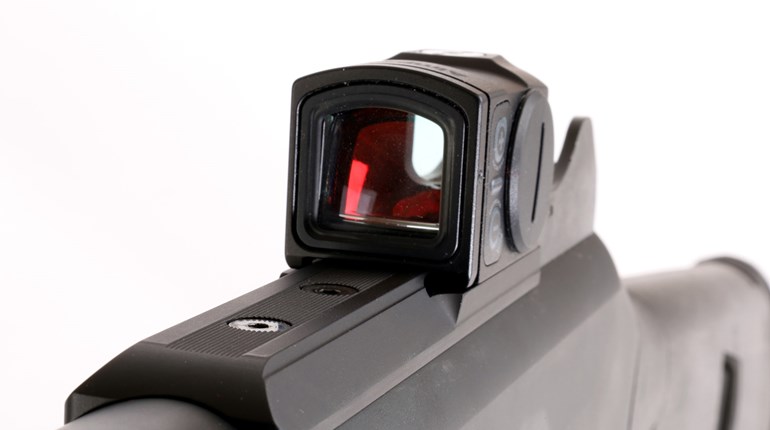
Aimpoint's new CompM4 sight combined with its 3XMag magnification module adds a great deal of versatility to a rifle platform. Though primarily intended for AR-type rifles, adapters from Fulton Armory and LaRue Tactical allow it to work on this Springfield Armory SOCOM II very well.
Gun technology is evolving at an increasingly rapid pace. Materials combining strength, durability, light weight and resistance to the elements once only dreamed about are now common. Electronics have been infused, especially into sights. Red-dot sights, pioneered by Aimpoint in the mid-1970s, have been transformed from a novel quirk of some hunters and competitive shooters to a must-have accessory for operators in harm's way around the world.
Early versions of the Aimpoint Electronic sight utilized two large mercury batteries to power its robust, encapsulated LED that formed the red dot. Battery life was somewhere between 500 and 1,000 hours, depending on the setting and the operating environment. A guy could get loaded down pretty good with all the different sizes and types of batteries needed to keep his electronic gear operating. For a tactical guy or a soldier, replacing batteries always occurs at the most inappropriate time—like when a bunch of bad guys are shooting at him. So Aimpoint developed its Advanced Circuit Efficiency Technology (ACET) and introduced it in 2000.
The ACET system utilizes an extremely small LED for the red-dot source mounted on the interior surface of the tube in such a way as to reflect virtually all of the light generated in it back to the shooter's eye. Thus, power demand is reduced, and battery life is increased. Aimpoint claims the CompM4 has a battery life of some 80,000 hours—more than eight years of continuous service.
Two features set the CompM4 apart from its predecessors. First is its utilization of a AA battery as a power source instead of the smaller 3-volt lithium-ion batteries, which may be difficult to find in some circumstances. Standard AA batteries are available worldwide, and though voltage may differ, depending on where the battery is obtained and its quality, Aimpoint has addressed this with an ultra-tiny internal voltage regulator. The other feature new to the CompM4 is its integral QRP2 Picatinny rail mount.
Simpler is stronger, and the QRP2 mount has more than twice the clamping force of the original QRP system. A single, ratcheting, torque-limiting knob makes it easier to mount the sight and lessens the chance of an overzealous operator breaking the mount. The CompM4 comes with spacers to allow installation on virtually any AR flat-top variant. I, however, wanted to be a bit more brutal in my evaluation and mounted it on a Springfield Armory SOCOM II, figuring to subject it to .308 Winchester recoil.
A challenge arose when I also wanted the capability of using Aimpoint's 3XMag magnifying module. The M1A/M14 platform was never designed to accept an optical sight mounted on the rear half of the receiver, so a couple of modifications were needed. I had to remove the stripper clip guide pinned to the receiver and install a Cartridge Clip Guide Scope Mount Base from Fulton Armory. The 3XMag has a clever twist mount for use on the AR platform, but on the SOCOM II it does not have enough real estate to work, so I found a LaRue Tactical Mount LT602 that replaces the Aimpoint twist mount. The LaRue Tactical Mount LT602 has a throw lever that is adjustable in its clamping force and about as quick as the Aimpoint twist mount. All of this set the sight pretty high on the SOCOM II, so I strapped on a Blackhawk cheekpiece to the buttstock.
Sighting the SOCOM II was a snap. Basically it's a two-shot zero. Shoot one round sighting dead-center at 25 yards. Adjust the CompM4 to put the dot on the bullet hole in the target, and shoot a confirmation shot. Done. The 3XMag has adjustments as well, but they are not for zeroing the rifle. They are simply to center the magnification module with the CompM4 sight. Zero does not change when switching from the sight to the magnification module and back.
The CompM4 has been chosen for the U.S. Army's M68 CCO (Close-Combat Optic) and is currently being used in Iraq and Afghanistan—small wonder. I found it very easy to use, and combined with the 3XMag module, it allowed for much better shot placement at ranges out to 300 yards. The 8-year battery life and utilization of readily available AA batteries, along with its rugged construction, make this one heck of a sight system, especially with the added versatility of the magnification module.




































